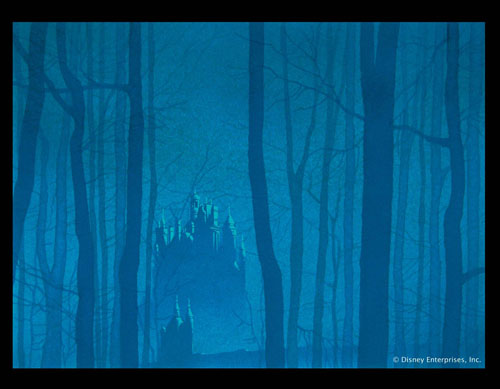ANALYSIS
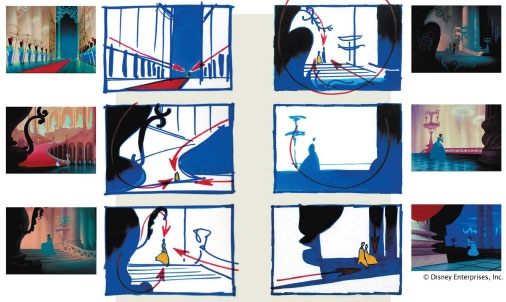
The scenes on the left from Cinderella. show you how well-planned every single composition was. Note the Framing Effect and how all the background elements lead toward the characters. In addition, the action in every frame is clearly readable.
Look at the first scene where Cinderella enters the castle and seems to be lost within the huge architecture. You find her immediately; all the perspective lines lead you there.
In most of the other shots, you can find the same concept — big foreground elements frame the action; the characters are on a theatre stage in a pool of light.
The whole movie feels like a romantic theatre piece, like a Puccini Opera stage. Compare the simplicity of the designs to recent productions. Even with very few characters, they are able to tell a funny and very entertaining story. Joe Grant told me they did the whole movie in nine months! No wonder, after all the experience of the preceding masterpieces.
On the right, I have collected some more stunning compositions. There is no need to talk about the incredible style — Mary Blair. What else can I say?
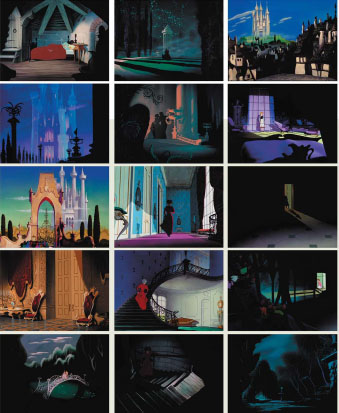
..LEARNING
Sketching from real life is very useful. For a character designer it is important to watch people and their behavior; a production designer additionally studies the environment, architecture, styles and colors. TV offers a lot of these real-life images in hundreds of channels. I do sketches while watching TV. However, you are so limited because you are not fast enough and there is so much more going on.
During the early nineties, the quality of the video-printers improved a lot. I spent hours taping all different interesting programs to go through them afterward and print thousands of moments for reference.
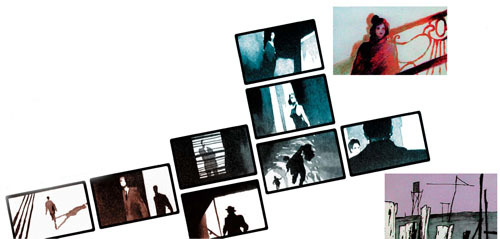
In previous years, you were limited to creating your image archives by collecting magazines or doing your own reference photography. It was a very time-consuming job. Cutting out and sorting, took a lot of space and lots of boxes.
With the video prints all that improved. The Discovery Channel offered everything you ever needed for wildlife research, not to mention everything available on VHS, Laserdisc, and DVD.
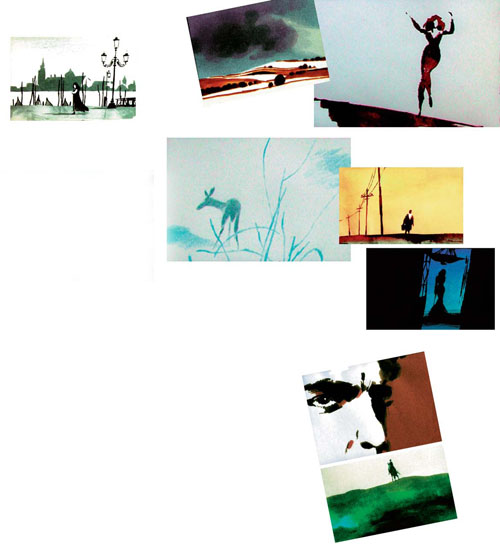
Well, over the years I have collected several thousand images in video prints. Very useful for all different assignments, but even more useful to get inspired. Just looking through the dozens of books with video prints gave me so many ideas.
It is even easier now, and cheaper. With available software, you create archives in your computer — no need for expensive prints. Moreover, it is then very easy to find what you are looking for with archiving software programs, not to mention that the picture quality is much better
CHOICES
The choices are endless! Even without a background, just dealing with one character, you have a lot of choices about where to place the action. Does the story ask for a closer look at the face? Or do you need to be further away? On what side of the screen would it work? Closer to the edge, or more in the golden section? Do I choose an up-shot or a down-shot? A center-position usually looks boring, but would it work in this case? What do I want to say?
It gets a lot more interesting and challenging with two or more characters. What is the interaction? Do I need to show them up close, or does space between them characterize their relationship? Who is the dominant character? A size difference will make that clearer.
When you add background to your character-composition more choices come up. You can separate them by dark in front of light, or light in front of dark placement. So far we have not even added detail to our background, detail that has to be treated the same way as the action. I want to explain some examples of this visualization in the next chapters.
FILM ANALYSIS
Most of my knowledge about composing and editing for film comes from watching and analyzing a lot of movies, commercials and music clips. After a while, you find out about the rules and understand why a film has been done a certain way visually and rhythmically to enable you to forget you are watching a movie. Bob Zemeckis, one of the great directors, said while I was working on Roger Rabbi, “We want the audience to forget they are sitting in a movie theatre, we want them to live in our movie.” Maybe you’ve had that experience. If the music was an integral part of a film, you may not remember afterward that there was any music throughout the movie. Music helps to create emotions. To do the same with the visual part you have to understand a few things.
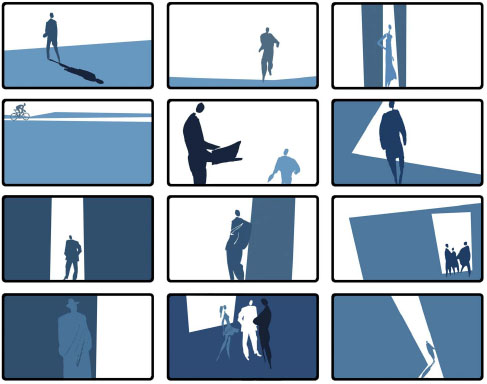
Choosing a good film to study helps one to find out about the rules. I am sure you can see the difference between just ordinary movies and the good ones. It has nothing to do with taste.
Following is a list of my personal top choices. You will notice that a lot of them are black & white films. Maybe you can concentrate better without being confused by colorful backgrounds, or maybe the better films are just black & white. But, there are some very good color movies out there as well. The problem with color is that it has to be designed as well. It’s not enough to just go outside and shoot a movie.
Alfred Hitchcock — Rebecca, Spellbound, Paradine Case, Dial M For Murder, Vertigo, Psycho, The Birds, Frenzy
Andrzej Wajda — Ashes and Diamonds, Danton
Baz Luhrmann — Moulin Rouge
Bernardo Bertolucci — The Conformist, The Last Emperor, The Sheltering Sky
Bertrand Tavernier — Sunday In The Country, Beatrice And The Great ‘Film Noir’ Director
Billy Wilder — Double Indemnity, Sunset Boulevard, Witness for the Prosecution
Carl Reiner — Dead Men Don’t Wear Plaid
Christoph Gans — Le Pacte Des Loups
David Lean — Oliver Twist, Bridge on the River Kwai, Dr. Zhivago, Lawrence of Arabia
Federico Fellini — La Strada, La Dolce Vita, 8 I/2, Satyricon, Amarcord
Franco Zeffirelli — Romeo and Juliet, Othello, Brother Sun, Sister Moon
François Girard — The Red Violin
Fritz Lang — Dr. Mabuse, Siegfried, Metropolis, M
George Cukor — My Fair Lady, Travels With My Aunt
Ingmar Bergman — The Seventh Seal, Wild Strawberries, The Silence, Winter’s Light
Jacques Tati — Mr. Hulot’s Holiday, Mon Oncle
Jacques Tourneur — Cat People, Out of the Past, Curse of the Demon
Joel Coen — Raising Arizona
John Boorman — Excalibur
John Frankenheimer — Grand Prix, 52 Pick-Up, French Connection
Ken Russell — The Music Lovers, Tommy
Michael Powell — Thief of Baghdad, Black Narcissus, Red Shoes, Tales of Hoffman
Michelangelo Antonioni -Blowup, L’Avventura
Mike van Diem - Character
Mikhail Kalatozov — The Cranes Are Flying
Milos Forman — Hair, Amadeus, Valmont
Norman Jewison — The Thomas Crown Affair
Orson Welles (My Personal Favorite) — Citizen Kane, The Stranger, Macbeth, Othello, Mr. Arkadin, Touch of Evil, The Trial
Peter Webber — Girl with a Pearl Earring
Peter Weir — Picnic at Hanging Rock, Year of Living Dangerously, Witness
Ridley Scott — The Duellists, Alien, Blade Runner, Legend, Black Rain, Gladiator
Roman Polanski — Repulsion, The Fearless Vampire Killers, Rosemary’s Baby, Macbeth, Chinatown, The Ninth Gate
Sergei Eisenstein — Battleship Potemkin, Alexander Nevsky, Ivan the Terrible
Stanley Kubrick — Barry Lyndon
Steven Spielberg — Duel, Jaws, Raiders of the lost Ark, Jurassic Park
Terry Gilliam — Time Bandits, Brazil, Twelve Monkeys
Vittorio De Sica — The Bicycle Thief Miracle in Milan
Wachowski Brothers — Matrix Trilogy
Wong Kar-wai — In the Mood for Love
Woody Allen — Shadows and Fog
Zhang Yimou — House of Flying Daggers
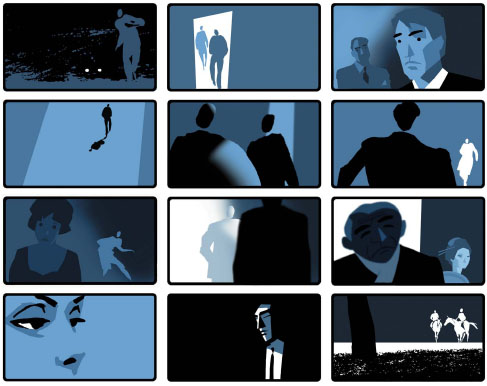
I suggest you choose a sequence in the movie of your choice. It should be visually engaging and interesting storywise. Don’t forget that we are not looking for pretty pictures, but that we want to know how to tell a story visually.
I usually sketch every single scene in small rough thumbnails, as if I was drawing the storyboard for the movie. These boards are just the other way around as they illustrate a finished film. In case there is a moving camera or the actors are moving, you need to do several key drawings to indicate the most important steps.
Depending on the length of the sequence, you may come up with several hundred sketches. Prepared pages with small story-board frames helps a lot.
Don’t forget to use the correct image ratio. The oldest film format is just 3:4. Today, we have Wide-screen — 1:1.85, Cinemascope — 1:2, and Panavision — 1:2.35. The correct image ratio is very important; otherwise, you get different composition results.
The next step is preparing the floor plans for the different environments in your sequence. This step is very important. Try to analyze and draw the details of the scenes such as in an architectural sketch, the main light sources with arrows, the position of the characters and their movements, and so forth. Then indicate the positions and movement of the camera. You may need several pages with the same floor plan in case there are some complex moves.
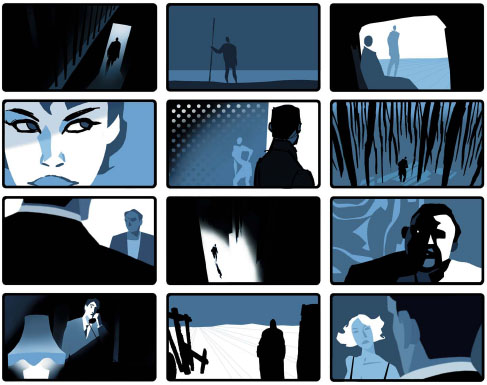
You will learn a lot about different lens sizes, as well as how to cut from one shot to the next. Wide-angle lenses are used to establish a sequence or to cover some major character movement. Close-ups are done with the camera close to the actor or with telephoto lenses. You will see the difference; a telephoto lens keeps even distant objects or characters closer together with an out-of-focus effect. A closer wide-angle has a deeper depth of field with a bigger size difference. I will explain that in more detail in another chapter.
Always note: Why did they use that lens here with that size and how did they cut from one shot to the next? How did they connect the characters following the dialogue and the story?
Camera-angles: How was the camera positioned? At eye-level? Or is it an up-shot, or a cut to a down-shot? And why? In a horror-movie, you will find a lot of scary up-shots together with some effective use of light.
Always indicate in your floor plan where the light source is. You will notice that light and shadow in a row of shots is very important for your orientation. It is useful as well to study how projected shadows onto characters or objects are used to create depth and additional texture. Hitchcock apparently had the scenic designers paint shadows of furniture detail on the wall once in a while if they could not achieve that same effect with original light and shadow.
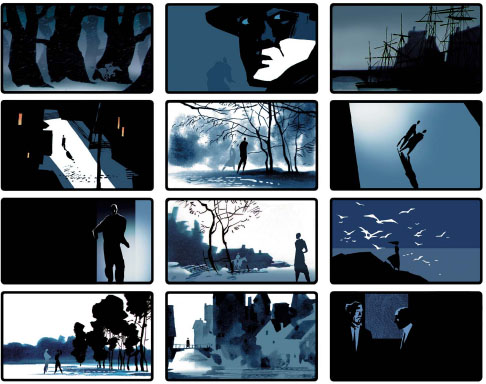
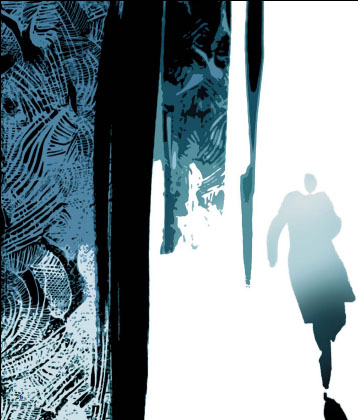
It is also interesting to analyze a moving camera. Antonioni is a master of that. Together with a very carefully choreographed move of his characters, he creates a voyeuristic effect; the audience is always in the center of the interaction between up to five actors.
We find a very different effect from that of a handheld camera in action sequences, together with a very fast editing and fast change of camera-angles.
Going through your thumbnails you can find out about composition rules, about the balance or un-balance in a shot, contrast and value, how the characters are staged and their integration in the environment.
The speed of editing creates a rhythm. Compare the length of different scenes. More emotional scenes have different lengths than action areas of a movie. Epic films such as Lawrence of Arabia have long establishing shots so that you feel the majestic power of the landscape images.
You will notice a lot of additional information in music-clips and commercials. Because of their restricted length and because they want to get all your attention within that short time, their rhythm- and composition-rules are different. And the images and their message are more important than a story. Often, you find crazy camera lens effects, manipulated colors, a shaky camera, grainy or ancient-looking film stock, as well as extremely fast cutting.

